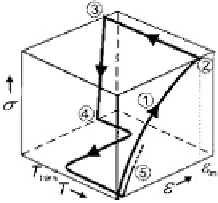Biomedical Engineering Reference
In-Depth Information
that such procedure, called training in SMAs, can take much longer
time, and deformation rates from the initial to the deformed shape
assume a much lower value. Also for other types of external stimulus,
understandable as different molecular switch reaction, polymer will
behave similarly as shown in Fig. 8.9.
Figure 8.9
Schematic representation of cyclic thermomechanical behavior
[20].
The irst step brings an elongation
ε
m
of the specimen that is
realized in the temperature range above
T
trans
, the molecular switch
is open and the stress-induced reaction of material is not blocked by
its bonds. After that, the strain is maintained to allow the relaxation
of the polymer chains.
When the sample is cooled below
T
trans
in the second step, the
molecular switches closes while the temporary shape that was
introduced in the earlier stage is retained (shape A in Fig. 8.7). The
third step reduces the applied stress, but the attained strain remains,
because of closed switches are blocked and elastically retained in
that state. The fourth stage brings the contraction and resumption
of the permanent shape of the specimen, with the temperature rise
above
T
trans
(shape B on a Fig. 8.7).
This short overview of shape memory materials should provide
a good introduction to the existing mechanism in the different types
of materials and its possible applications. It also brings a broader
vision of discussed behaviors and its similarities for the upcoming
section of this chapter.
8.3
Brief History of SMAs
Since the discovery of martensite in steels by Adolf Martens
around 120 years ago, scientists have wondered about the nature

















